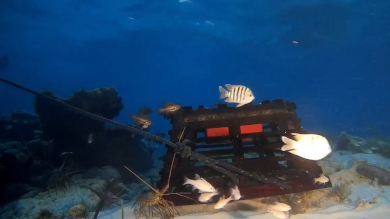When there’s a drought on the land the evidence of its impact is visible but in the marine environment it’s out of sight, not out of mind.
Fisheries researchers from the Department of Primary Industries and Regional Development (DPIRD) are working with commercial rock lobster and crab fishers to deploy and retrieve high tech cameras that film the marine environment and fish on their way down to the seabed as well as record the water temperature on the ocean floor.
The cameras are also georeferenced, meaning they can help build a database of what’s happening where in the marine environment.
By the middle of this year, more than 30 of the so-called POTBots will be deployed off Western Australia, which through regular data sampling will help fisheries researchers better understand habitat change along the coast.
In the past, underwater impacts of abnormal environmental conditions such as a marine heatwave or cold spells, were not able to be observed, but new technology is changing that.
During the 2011 marine heatwave off WA’s coast, the marine environment from Geraldton to Shark Bay underwent a significant habitat change, with the loss of algae and some sea grass.
POTBots, deployed by lobster fishers at the time, documented this change across a wide area and in isolated locations along the coast, such as north of Kalbarri and between Horrocks and Geraldton.
The POTBots also recorded a change in fish communities, including the appearance of large numbers of juvenile red-throat emperors as far south as Rottnest. This range extension of the tropical species is presumably a result of the marine heatwave and an associated strong Leeuwin Current. More recent POTBot vision shows these juvenile emperors have survived and grown in more southern waters, where they have now reached legal size and are being caught.
DPIRD Principal Research Scientist for Offshore Crustaceans Simon de Lestang said working with WA’s commercial lobster and crab fishers was delivering a great opportunity to find out more about the marine environment and how it is impacted by marine heatwaves or cold spells.
“DPIRD scientists are now helping the fishers expand this program and set up a wider spread of random sampling across the marine environment from Mandurah to Kalbarri and help us assess the impacts marine conditions have on the wider environment,” Dr de Lestang said.
“Significant habitat change can have major impacts on the productivity of our recreational and commercial fisheries, so learning more about our marine environment through new technology will give us better insight to what’s happening underwater.”
 The high-tech cameras provide a window to the marine environment
The high-tech cameras provide a window to the marine environment